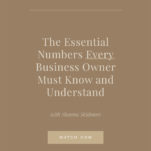Keep Reading
Five Numbers to Know and Track in your Business
I think we can all agree, finances is one of the most intimidating parts of running a business. Even as a former fortune 100 financial advisor with a business degree, I still get stumped from time to time on tax forms and the “right” way to do something when it comes to my business dollars. […]

Paragraph
I think we can all agree, finances is one of the most intimidating parts of running a business. Even as a former fortune 100 financial advisor with a business degree, I still get stumped from time to time on tax forms and the “right” way to do something when it comes to my business dollars.
I know you’ve heard it before so I won’t beat this dead horse too long, but according to many sources about 8 out of every 10 businesses don’t make it to five years and most of the reasons why are all financial:
- Misunderstanding of Cost
- Emotional Pricing
- Not planning for or saving for taxes
- Cash flow Planning (which means making sure there is enough money coming in each month to cover the bills, especially for you seasonal businesses out there!)
- And not having a proven business model (which just means the whole build it and they will come idea isn’t actually true in a lot of cases! We need to think about market fit, and pricing, and solving needs to ensure this thing will float!)
Disclaimer : The content is for informational purposes only and does not consistent legal or financial advice. This content does not replace the help of a local tax or legal professional.
The Five Most Important Numbers to know and track in your business
While I believe there are a few essential numbers EVERY BUSINESS OWNER must know and understand .. I don’t believe you need to go get a finance degree in order to run a profitable small business.
Did we just become best friends? YUP!
Since starting my company I’ve worked with thousands of business owners across the world in hundreds of industries from cake design to virtual assisting, photography to real estate and these FIVE NUMBERS TO KNOW ring true for every one of you!
So, today I thought it would be helpful if I bust the myth that you have to love math to be great a money and tell you the five most important numbers I know and track in my business every.single.year.
I’m going to share with you what they are, how I track them, and why these numbers are the most important.
This video is definitely one you’re going to want to bookmark and come back to on those days when money has you wanting to pull your hair out. And of course download the free numbers to know guide to go along with this video!
#1
TOTAL SALES
Total Sales : Also known as revenue.
This is the total amount of dollars you brought into you business in the past year from all income streams. That can mean services, products, passive income revenue. Think of this as the “dollars in” . Now you don’t have to have a fancy bookkeeping system to track all these dollars. While that will make it a lot easier to know this number quickly and with easy — I’ve had clients in the past literally pull out their planner for the year and review all the clients they booked. You can even write on a scratch piece of paper every client and the amount they booked with you.
Of course, all my product based companies or anyone who serves more than 30-40 clients a year this would be tedious and cumbersome. Many online shop softwares can pull these reports for you very easily.
#2
TOTAL EXPENSES
Total Expenses : Has been called by many names. Job Costs, Cost of Goods Sold, Overhead (probably the most familiar to you). Think of Expenses as the “dollars out” in your business.
This goes to pay to actually produce your goods or services (so material costs, job labor, shipping fees, etc), as well as general operating costs such as rent, employee wages, software fees, and professional development. If you’re like most entrepreneurs I meet, you find yourself sometime around April 15th digging up old receipts trying to get as many write-offs as you can come tax time. But despite popular belief, understanding where you are spending your money is not just important for properly filing your taxes. It tells you a TON about your business! If you’re spending too much on each project that means your price either needs to go up or your costs need to go down to produce a profit. That’s essential to know when pricing your goods and services!
Now again, a fancy bookkeeping software is going to be the easiest way to pull reports quickly and see your “profit and loss” month by month. This is a report I look at monthly during my Money Dates (I’ll link more about that below!). But you can do this by simply printing off you bank statements and getting highlighter happy.
(little tip : make sure you have a separate bank account for your business! This will make knowing your business expenses so much EASIER AND FASTER and truly is one of the very first steps to take a business owner!)
Related : How I Track my business finances month by month
#3
PROFIT
Profit : I lovingly refer to this number as “the leftover”. It’s a simple math problem really : total sales – total expenses.
Profit can also be called by many names but don’t get bogged down with the details. You just want to know how much money does your company have left over after “running it”. The IRS is also looking at this number at tax time to determine if and how much income tax you’ll owe from the business. I see a lot of creative entrepreneurs these days talking about six or seven figure businesses—throwing around a lot of fancy sounding jargon—but I don’t want you to be duped. There is a difference between six figures of revenue and six figures of PROFIT.
At the end of the day, I want my company to be profitable. This is the numbers that matters to me. There are some years revenue goes up and some years revenue goes down but what matters is profit at the end of the day.
Related : How I calculate my financial need in my business
#4
AVERAGE SALE BY CLIENT (OR PRODUCT)
As a service based professional this shows you what you’re making on average per client.
For instance, if a wedding photographer brings in $100,000 in revenue for 20 clients, she is making on average $5,000 per client. You can find this number by dividing your total sales for the year / the number of clients you served that year. Of course you might have had a client pay $7500 and some pay $4000 but it’s good to look at the average.
But a word of caution here : AVERAGES are skewed by outliers! If you had one big $20,000 and the rest for $2,000 it’s also important to also calculate your average without that outlier. Just like with the whole “six-figures” idea … be careful when someone is going around boasting about their giant client average. While this might be true, it’s good to also know if they had any outliers that are skewing that number!
For product based professionals or online shops I look at this number based on products offered, or by launches, or by month!
For our education site I currently offer three online products : The Blueprint Model, Blueprint at Home—my personal finance course—and My Blueprint Year, our annual planning course. I look at what each of these courses made for the year and see what percentage of total sales they account for.
For my artists : Many of them launch “collections” 2-4xs a year. I like to see how much each collection launch brought in and then what percentage of total sales.
For any online shops or brick and mortar : look at this number by month. Average sales per month and then calculate your top three months for sales.
Ps. This calculation and analysis is how I teach my students in The Blueprint Model to take sabbatical! So much more I could share on that, another day!
Learn More : The Blueprint Model Online Business Course
#5
OWNER PAY
Last but not least, how much money you paid yourself! Many entrepreneurs I work with go years without paying themselves a steady paycheck. There are so many reasons why : fear, not understanding money, not having enough money, etc. But paying yourself shouldn’t be a luxury, it is a requirement. Just like overhead and product costs, paying yourself is a sign of health in your company.
How to analyze these numbers and use them to actually work smarter not harder!
These numbers are important because they tell you something about your business.
For total sales I look at the increase or decrease year over year. It may surprise you to know I don’t always look for increased revenue. There are some years (having a baby for instance!) that increased revenue isn’t the goal. I also use this number to look at the services or products that are most profitable. Inside my business program, The Blueprint Model, I teach students how to analyze these numbers to put their energy where it matters most! Most entrepreneurs – let’s face it- most humans are busy busy busy! We have to learn to be professional sifters and put our energy where it matters most!
I also look at my expenses to see the profitability of each of my products and services as well as where the business funds are being reinvested. I want to make sure my employee salaries, rent spending and professional development are in line with revenue and not overspending in one area or another. You can find a lot of recommendations online as to what percentage of revenue you should be spending on advertising, rent, etc for your industry. I also teach this in my business program, The Blueprint Model, with exact recommendations on spending amounts for each of these overhead categories!
Profit is like balancing the checkbook, you always want to make sure your ending number stays positive and not negative!
Client Averages is an important number. This is actually the number I do like to see increase over time (for service based professionals). This shows that your price is trending up as your skills increase well and also shows if you’re getting fewer of the “right” clients for less. For product based professionals I like to see fewer products bringing in more revenue with the ability to cut less income producing products. These numbers tells me a lot about energy management! If a client comes to be exhausted this is one of the first numbers I look at!
Last but not least, how much money you paid yourself!
Many entrepreneurs I work with go years without paying themselves a steady paycheck. There are so many reasons why : fear, not understanding money, not having enough money, etc. But paying yourself shouldn’t be a luxury, it is a requirement. Just like overhead and product costs, paying yourself is a sign of health in your company.
Ok, we could go into so much more detail on these numbers but I hope this gets you started. Here’s the deal, you don’t have to be an accountant or understand the IRS handbook but as a business owner knowing and understanding your numbers is essential to working smarter not harder. I have no doubt even as a “non-money” person you have the ability to understand the few essential numbers you need to know to run a profitable company!
If you found this video helpful will you like it and leave us a comment!
(Also, make sure to subscribe so you’ll be notified when new content drops!)
If you’re struggling to make money doing what you love without working yourself into the ground—knowing these numbers will help! We would love to see you in The Blueprint Model!
Til next time,
Shanna
NEED HELP GETTING YOUR SMALL BUSINESS FINANCES IN SHAPE?



KEEP READING:
Five Numbers to Know and Track in Your Business
A 3-Step Plan to Replace Your Corporate Salary with Business Income
How to Manage Small Business Finances | Monthly Money Workflow
SHARE THIS:
January 4, 2021
Previous Post:
Next Post:



And if you found this helpful, share with your friends!